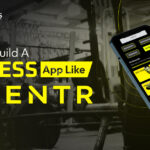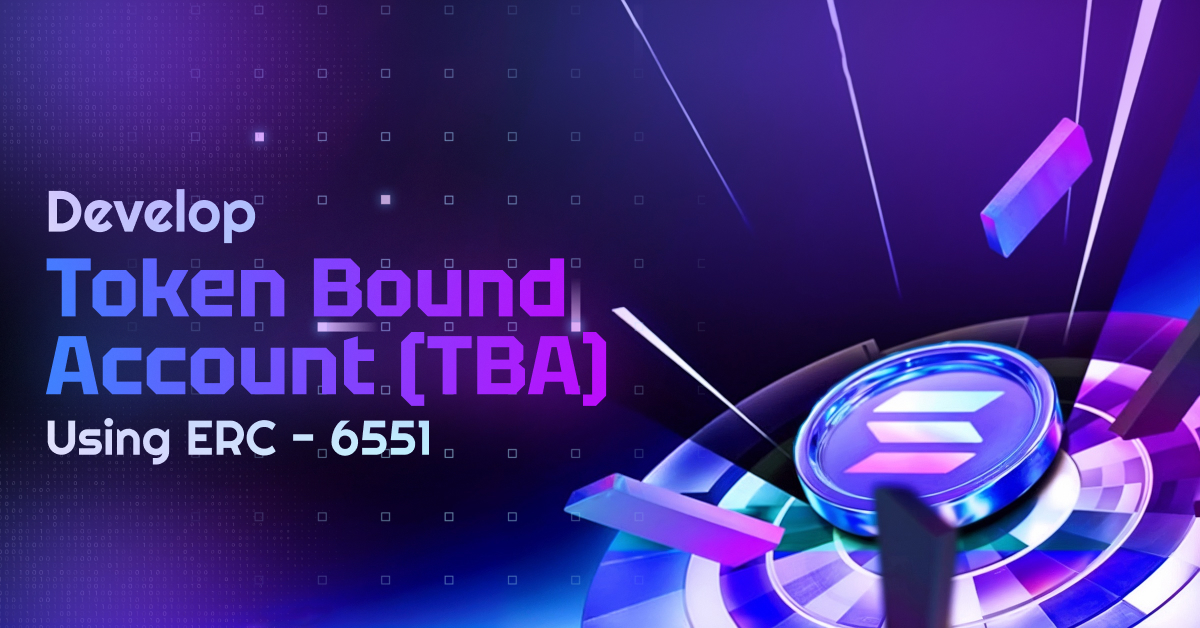Remote patient monitoring software (RPM) is cutting-edge technology that allows healthcare specialists to monitor patients’ vital signs and health data in real time. This system not only enhances patient care and improves efficiency for healthcare businesses but also reduces the healthcare cost. As a result, demand for RPM software is increasing rapidly.
Additionally, I have research that the remote patient monitoring systems and services market was valued at USD 6.9 billion in 2022 and is expected to grow at a compound annual growth rate (CAGR) of 25.71% from 2023 to 2032 when it is expected to reach approximately USD 68 billion.
Quick Summary: This blog will help you understand the cost to build a remote patient monitoring software, the cost-influencing factors, and the techniques for reducing the cost. It will also help you understand how RPM software works, which tech-stack must use, its key financial benefits, and how to make money with the software.
Hence, investing in remote health monitoring system development is not just a wise financial decision but also a lucrative business opportunity to tap into a rapidly growing healthcare market. So, if anyone wants to build a remote patient monitoring software but is unfamiliar with its development cost, this blog is for you.
What Is the Remote Patient Monitoring Software?
Remote patient monitoring software is healthcare software that allows patients to track their health condition with wearable devices and smartphones. The data is transmitted carefully to the cloud platform, where the software examines it. Remote patient monitoring platforms present this information to health providers in a clear format, highlighting potential issues, if any.

Providence Health $ Service (a world-renowned healthcare organization) has stated that RPM software has tackled major challenges, including workforce shortages and burnout, throughput, hospitality capacity, and care fragmentation.
Market Analysis of Healthcare Software
- Digital Treatment & Care market sales are expected to reach US$73.84 billion by 2024.
- This market is predicted to have a projected volume of US$112.60 billion by 2028, growing at a compound annual growth rate (CAGR) of 11.12% from 2024 to 2028.
- The user penetration rate is expected to reach 37.30% by 2028 from its predicted 28.40% in 2024.
- The average revenue per user (ARPU) is predicted to be $33.55.
- In terms of worldwide revenues, the United States is anticipated to yield the biggest amount in 2024, equal to US$24,240.00 million.
Projected global digital health market size from 2019 to 2025* (in billion U.S. dollars)

Source: Statista
The expected value of the worldwide digital health market in 2019 was $175 billion. The digital health sector is expected to develop at a compound annual growth rate (CAGR) of around 25% from 2019 to 2025, when it is valued at approximately 660 billion dollars.
How Does Remote Patient Software Work?
Do you know how remote patient monitoring software solutions work? If no, to make understand of how RPM software works for both healthcare providers and patients, look at the explanation table below:
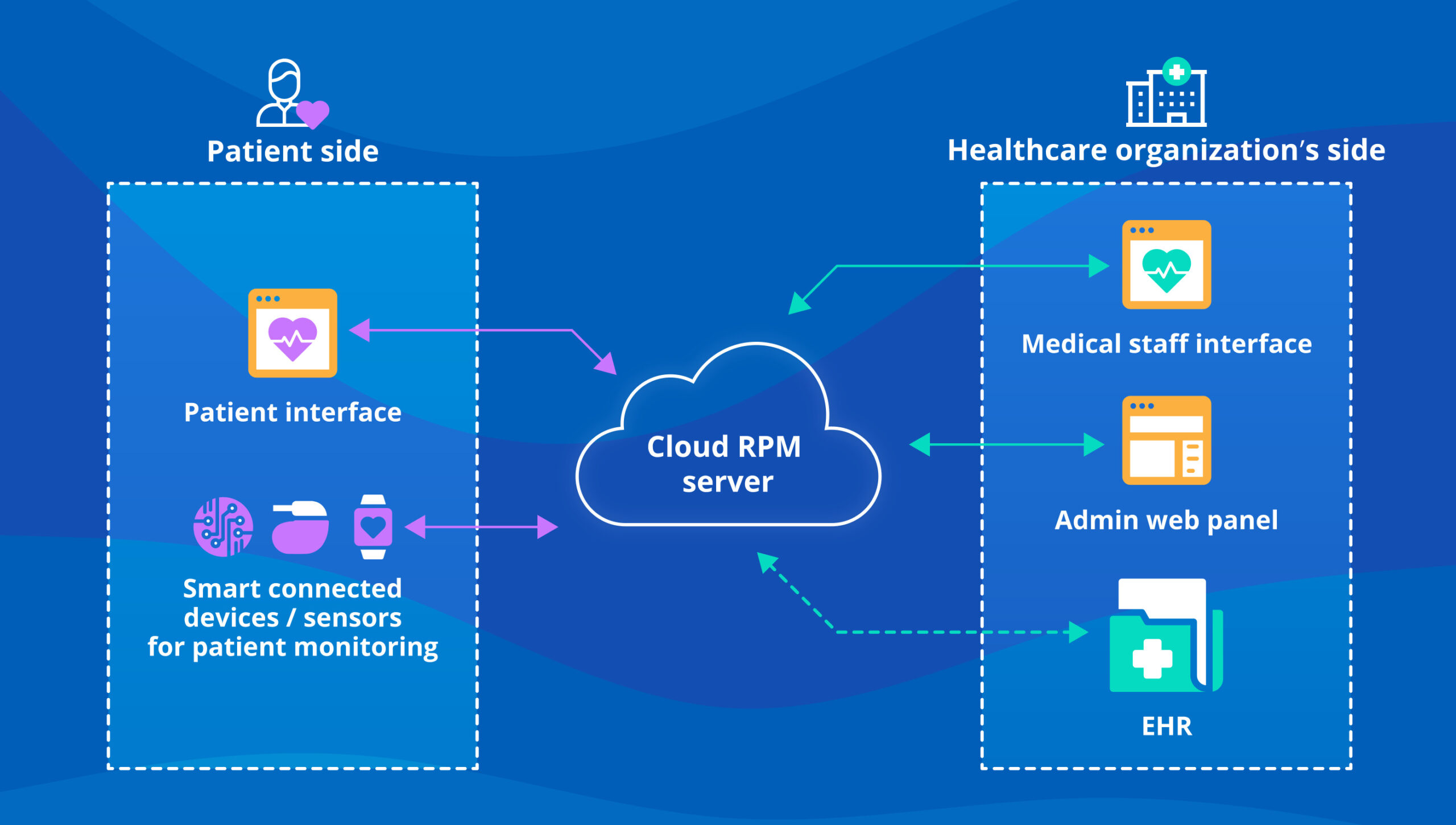
| Aspect | Patient’s side | Healthcare provider’s side |
| Data Collection | Patients use smart devices to track vital signs such as body temperature, sweating, and blood pressure. | Using smart devices or sensors to collect patients’ data and send it to a cloud-based RMS server. |
| Data Transfer | Patients use communication methods, including NFC and Wi-Fito, to communicate their health data to the cloud RPM server for analysis. | Healthcare organizations employ existing connections and guarantee a smooth transfer of patients’ data to the cloud RPM server. |
| Cloud RPM Server | The cloud RPM server collects, organizes, and evaluates patient’s health data to offer insights about changes in healthcare status. | Use the cloud RPM server to collect, analyze, and find patterns and deviations. |
| Notification and Alerts | Patients can report symptoms and receive later information about potential device issues for medical attention. | Receive alerts that enable healthcare providers to take immediate action during abnormalities in patients’ vitals or faulty devices. |
| Medical Staff Interface | Patients can schedule video consultations with their healthcare specialist through mobile apps, providing personalized care and guidance. | Healthcare specialists provide medical professionals with an interface to access patients’ health data, enabling remote monitoring and care. |
| Administrative Management | Patients can use mobile applications to schedule appointments, update personal information, and manage health data visibility. | Healthcare providers use admin web panels to set up system settings, book appointments, and manage user roles. |
Read More: Mental Health EHR Software Development
Top 5 Remote Patient Monitoring Software
If you want to build a remote patient monitoring software, you must study the existing alternatives during the planning and research phase. It will help you to evaluate the remote patient monitoring market needs, identify gaps, and design innovative and competitive remote patient software accordingly.
- Luma Health
- CarePaths EHR
- Philips
- CharmGealth
- Updox
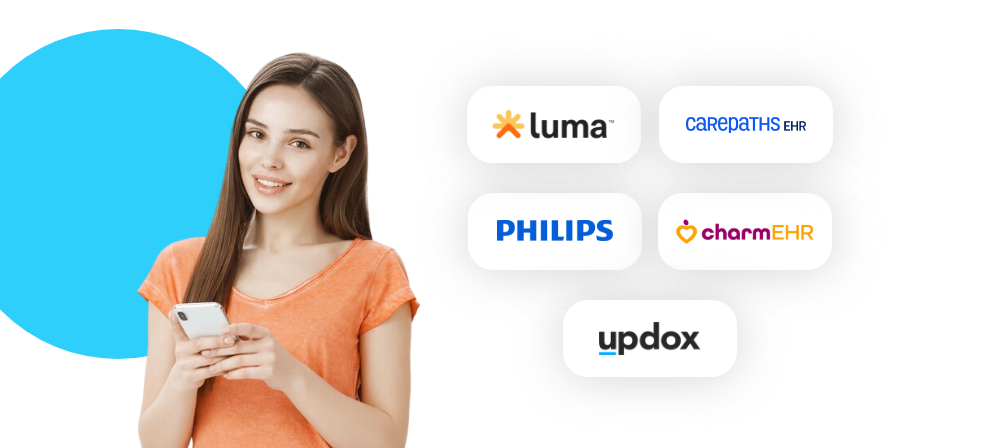
1. Luma Health
- Apps: The software provides mobile applications for both health providers and patients.
- Feature: It secures messaging, virtual visits, medication management, and remote monitoring capabilities for different conditions.
- Award: It has won the Fierce Healthcare 15 Disruptors Award in 2020.
- Technologies: Secure messaging protocols, cloud-based platform, integration with different medical devices and EHR systems.
2. CarePaths EHR
- Apps: It may or may not offer patient-facing applications spending on a particular EHR system.
- Features: It monitors functionality and is integrated into the EHR system, allowing for tracking vital signs and medication adherence.
- Awards: Best in KLAS category leader
- Technology: Secure data encryption, web-based EHR platform, and potential integration with remote monitoring devices.
3. Philips
- Apps: Philps offers different patient monitoring applications that can be used to monitor the patient, depending on the particular solution.
- Features: The software provides a comprehensive suite of RPM solutions for different conditions, including sleep disorders respiratory, cardiac, and maternal-mental health.
- Awards: Won the “Best New Technology Solution for Radiology” award
- Technologies: Depend on particular solutions, which may include a cellular network, Bluetooth connectivity, and secure cloud storage.
4. CharmHealth
- Apps: CharmHealth offers mobile apps for both healthcare providers and patients.
- Features: Medication adherence monitoring, educational resources, secure messaging, appointment scheduling, and remote monitoring capabilities.
- Awards: Healthcare Informatics Top 100 Companies (2020)
5. Updox
- Apps: It’s a unified place for managing all the work and communication. It integrates with most EMRs, ensuring safe and efficient care.
- Features: Remote patient monitoring, patient engagement, and practice management
- Technologies: Cloud-based platform with secure data encryption protocols. It is also integrated with most Electronic Health records.
As a software developer, I have worked for different industries, including healthcare. However, some time ago, I had an opportunity to create remote patient monitoring software, which was a good opportunity for me. When working on it, I observed that such healthware software is in high demand, reducing patients’ and healthcare providers’ time. Telehealth solutions facilitate face-to-face appointments online. However, when developing the remote patient software, I realized that it involves a huge cost, and I had to find a solution to reduce it. Hence, after some efforts, my team and I found effective ways to reduce the remote patient monitoring software development cost that you will find in this blog. So, get ready to bring your dream of patient monitoring software development to life. :: Pramod (Project Manager)
5 Key Financial Benefits to Develop Remote Patient Monitoring Software
Undoubtedly, the healthcare industry has experienced a major transformation with advanced technology. Most businesses have started to invest in this to extend their businesses. However, as per the healthcare software development company if you build a remote monitoring software for patients tracking, you can enjoy the following benefits:
- Reduced Cost
- Improved Efficiency
- Increased Revenue
- Enhanced Patient Engagement
- Data-driven Decision Making
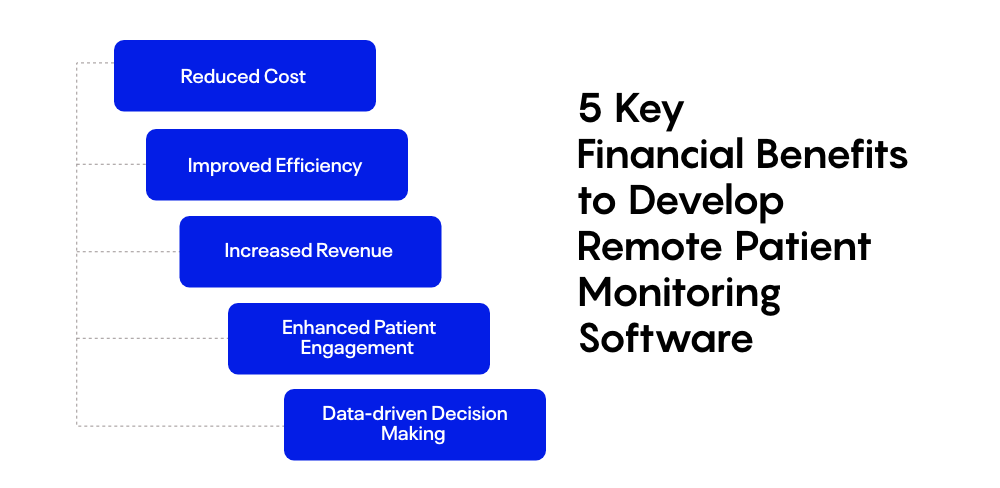
1. Reduced Cost
Remote patient monitoring makes it easy to identify health issues early, preventing costly emergency room visits. Additionally, it minimizes increased in-person appointments, freeing up resources for those who really need them.
2. Improved Efficiency
Remote patient monitoring automates data gathering and analysis, streamlining workflow for healthcare organizations. As per the remote health monitoring services provider, this reduces administrative burden and allows them to focus on patient care.
3. Increased Revenue
By investing in remote patient monitoring, we can earn more revenue by improving patient care, streamlining operations, and reducing hospital readmissions. It also increases patient engagement and enables proactive health care that leads to better outcomes and higher patient retention.
4. Enhanced Patient Engagement
Remote patient monitoring apps allow patients to take charge of their health. By promoting self-management and real-time data, the software increases patient engagement. It leads to better adherence to treatment plans and lower overall healthcare costs.
5. Data-driven Decision Making
A real time health monitoring system collects valuable patient data and information that can be used to improve care delivery. Healthcare organizations can analyze, provide an analysis of patients, identify at-risk patients, and personalize treatment plans. Hence, it leads to cost-effective interventions.
Cost To Build a Remote Patient Monitoring Software
Building an RPM software requires a strategic investment encompassing research development, implementation, and maintenance costs. Hence, based on a range of factors, the healthcare website development cost can be estimated at around $8,000 to $26000. This cost to build a remote patient monitoring system varies on the apps’ complexity level as mentioned in table below:
Cost Breakdown to Build a Remote Patient Monitoring Software
| Remote Patient Monitoring Software Development | Estimated Cost | Time Frame |
| Simple Remote Patient Monitoring Software Development | $8000 – $13000 | 3 to 6 Months |
| Medium-Complex Remote Patient Monitoring Software Development
|
$13000 – $21000 | 6 to 9 Months |
| High-Complex Remote Patient Monitoring Software Development | $26000+ | 10+ Months |
If you want to know more about the cost of healthcare software development, contact a software development services provider. Remote patient monitoring software companies will help you to prepare a budget as per your project’s requirements.
Top 5 Factors Affecting the Cost To Build a Remote Patient Monitoring Software
When calculating the cost to develop a remote patient monitoring software, consider different factors that can influence the overall development cost. Here is a list of top key factors that can influence the cost of custom software development:
- Software Design
- Software Complexity
- Location of the Development Team
- Software Customization
- Compliance and Security
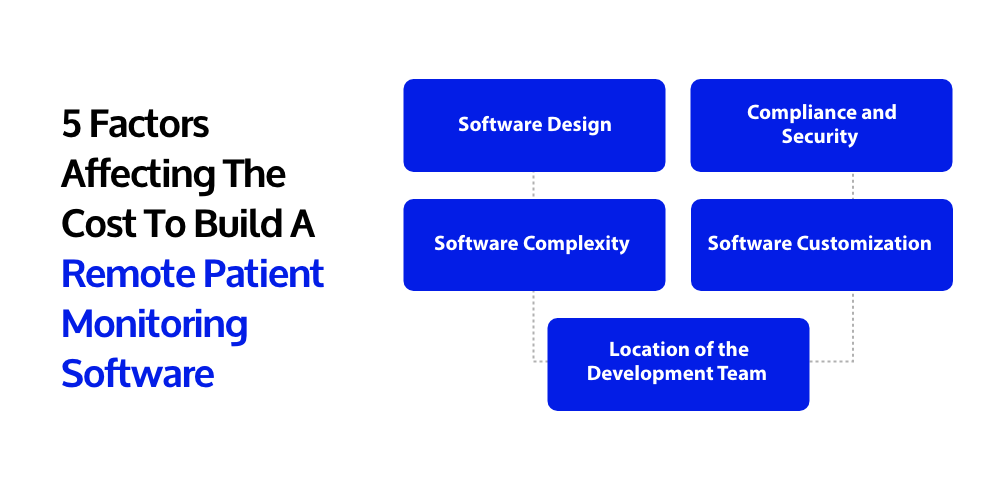
1. Software Design
A seamless user experience and intuitive user interface are critical, ensuring that healthcare providers and patients can use the software effectively. However, this requires a heavy investment that increases the cost.
2. Software Complexity
If you want to add advanced features such as real-time data tracking and sophisticated analytics, the software’s complexity level will be increased. It requires more resources and energy, which demands more investment.
3. Location of the Development Team
If you hire a custom software development company in Western Europe or North America, then the chagrin rate will be higher. On the other hand, if you hire a healthcare software development company from Asia or Eastern Europe, you have to spend less.
4. Software Customization
Customizing your remote monitoring platform to meet the diverse needs of healthcare providers and patient demographics will require additional development time, which will also increase complexity and costs.
5. Compliance and Security
It’s critical to ensure compliance with regulations such as GDPR or HIPAA in your healthcare CRM software. However, this involves additional costs for legal advice, documentation, and the implementation of significant security measures.
How To Reduce the Cost To Build a Remote Patient Monitoring Software?
If you are concerned with the increased RPM or medicine delivery app development, you can adopt the following key teachings to keep the development cost low:
- Prioritize Features
- Focus on Security
- Target the Right Development Team.
- Cloud-based Solutions
- Telehealth and Wearable Integration
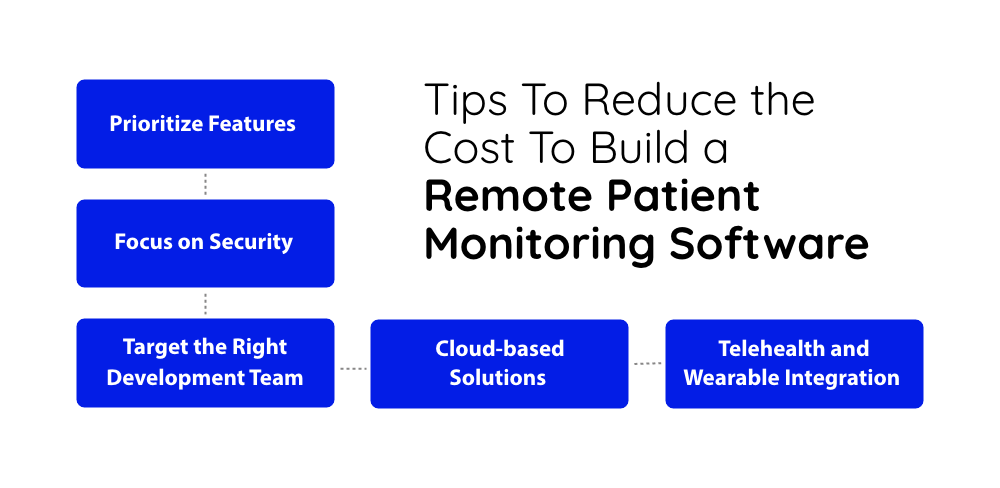
1. Prioritize Features
Consider the core features that are critical for your app launch. Adding unnecessary features can increase the cost to develop a healthcare app, so selecting limited features can reduce the overall development cost.
2. Focus on Security
When lowering the remote patient monitoring software pricing, prioritize robust security measures that ensure patient data privacy. Hence, it prevents data breaches and reduces your remote patient monitoring pricing later.
3. Target the Right Development Team
Evaluate outsourcing options. Prioritize regions with a strong development talent pool have lower remote patient monitoring cost. It will help you reduce the cost of remote monitoring software without compromising quality.
4. Cloud-based Solutions
Cloud services can store and process data, helping minimize healthcare software development costs. As per the cloud app development services providers, platforms like Azure, AWS, or Google Cloud offer scalable solutions, eliminating the upfront cost of setting up physical servers.
5. Telehealth and Wearable Integration
Incorporate existing wearable devices and telehealth platforms. This can save the time and cost of software for remote patient monitoring associated with building and testing hardware and software integration from scratch.
How to Make Money With Remote Patient Monitoring Software
If you want to make money with your best remote patient monitoring software while providing value to patients and healthcare providers, adopt the following techniques:
- Subscription Model
- Freemium Model
- Targeted Advertising
- Per-patient Monitoring
- Value-based Care Integration
1. Subscription Model
This popular app option offers a tiered plan with different features. A basic plan covers monitoring, while premium tiers include medication reminders, advanced analytics, or telehealth consultations.
2. Freemium Model
This technique offers a free basic version with a few functionalities. It entices users to experience the value of your remote monitoring healthcare software and update to a premium plan for advanced features.
3. Targeted Advertising
Consider software’s minimal, non-intrusive advertising. This could focus on the patient’s relevant healcth-related goods or services. However, you have to maintain patients’ confidence and confidentiality.
4. Per-patient Monitoring
You can charge healthcare organizations fees for patients enrolled in remote patient monitoring software. As per the software product development services provider, this can benefit healthcare organizations which have many patients who need remote monitoring.
5. Value-based Care Integration
Collaborate with helactahre organizations using a value-based care model. The remote patient monitoring software can help them depict improved patient outcomes. Hence, it leads to higher reimbursement rates.
Key Feature of Remote Patient Monitoring Software
What makes software successful? The features? For a successful doctor on demand app development, ensure it meets the user’s ever-changing requirements. If you are unaware of how to develop such software, consider the following key features.
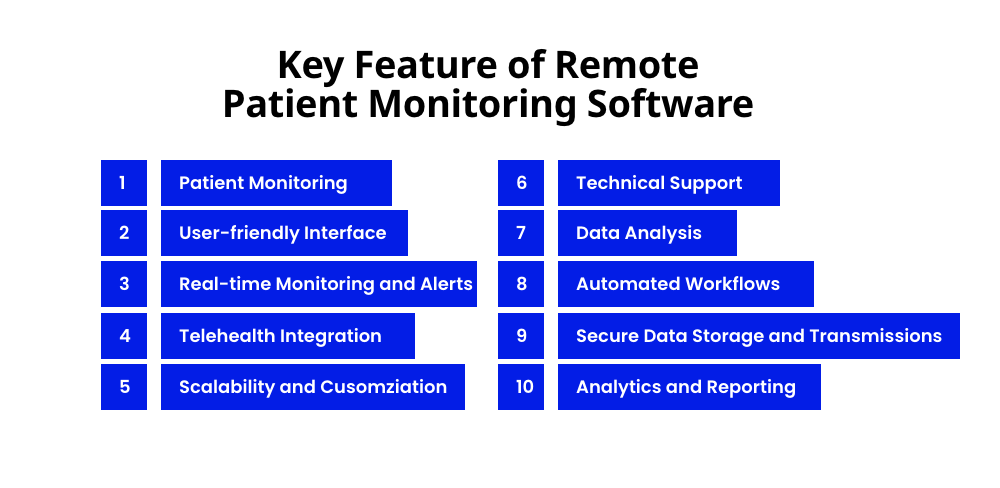
| Patient Monitoring | Allow helactahre providers to remotely monitor their patients’ vital signs and other health data to identify healthcare problems. |
| User-friendly Interface | Simplicity is key to both health providers and patients. An intuitive interface maximizes engagement and minimizes confusion. |
| Real-time Monitoring and Alerts | Ensure your app can track patient data in real-time, enabling a faster inventory when readings deviate from normal ranges. |
| Telehealth Integration | This feature facilitates two-way communication between healthcare specialists and patients through video calls for virtual consultations. |
| Scalability and Cusomziation | Build commercial service software for healthcare that adapts to your diverse needs and grows with your practice. |
| Technical Support | With reliable technical support, ensure timely assistance with any technical issues for patients and health providers. |
| Data Analysis | Your software must include a data analytical tool to analyze patterns in patient data. This tool helps health providers make informed decisions about patient care. |
| Automated Workflows | Ensure your software automates repetitive tasks like data transmission and analysis, which frees up valuable time for clinical decision-making. |
| Secure Data Storage and Transmissions | Build a remote patient monitoring software with robust security protocols, protecting patient’s sensitive health information. |
| Analytics and Reporting | This feature helps monitor software effectiveness, track patients, and comply with regulatory reporting requirements. |
Tech Stack for Remote Patient Monitoring Software Development
When building a leading remote patient monitoring software, businesses consider the technology used in its development. As per the SaaS development services providers, it helps to ensure security, scalability, and optimal performance that enhance patient care and data management efficiency.
| Component | Technologies |
| Frontend | React Native, Flutter, Swift, Kotlin |
| Backend | Node.js, Java (Spring Boot)
Python (Django/Flask), |
| API Integration | GraphQL, RESTful APIs, SOAP |
| Database | SQLite, PostgreSQL,MySQL, MongoDB, Firebase |
| Analytics | Google Analytics, Firebase Analytics |
| Authentication | OAuth, JWT |
| Push Notifications | Apple Push Notification Service, Firebase Cloud Messaging |
| Version Control | Git, GitHub, Bitbucket |
| Deployment | Apple App Store, Google Play Store, TestFlight, Firebase App Distribution |
Conclusion
Remote patient monitoring is a significant and cost-effective tool in the modern healthcare market. It offers a range of benefits for both helactahre providers and patients. The demand for such healthcare software is increasing day by day. Businesses are looking to invest in this. However, they are not sure about its development cost and hold on to their software development idea.
If you are also looking to build a remote patient monitoring software at an affordable cost, consult a medical device software development company. For instance, Dev Technosys is a reputed app development company with talented developers. We at Dev understand the significance of healthcare software and can help you attain your business goals.
So what are you writing for? Just share your software’s requirements with us and touch new business heights.
Frequently Asked Questions
Q1. What Is The Cost to Build a Remote Patient Monitoring Software?
The cost to develop a remote patient monitoring software can fluctuate as per projects’ requirements as mentioned below:
- Simple remote patient monitoring app development: $8000 – $13000
- Medium complex remote patient monitoring app development: $13000 – $21000
- Complex remote patient monitoring app development: $26000+
Q2. How Much Time Will It Take To Build a Remote Patient Monitoring Software?
The timeline for developing remote patient monitoring software can vary depending on its complexity level. However, on average, the time required is 3 to 10 months.
Q3. How Do You Build A Remote Patient Monitoring Software?
For a successful EHR software development, follow the steps:
- Conduct Market Research
- Choose the Best Tech Stack
- Craft an Intuitive UI/UX
- Develop the App
- Testing and Quality Assurance
- Launching and Marketing
- Provide Continuous Support and Upgrades
Q4. Why Is Real-Time Monitoring Significant In Health Care?
Real-time patient monitoring enables healthcare organizations to track their patients’ vital signs and health issues, enabling early detection of changes to abnormalities in patients’ conditions.
Q5. Why Should We Choose Dev Technosys To Build A Remote Patient Monitoring App?
Dev Technosys offers a scalable solution that supports the desired patient condition. Additionally, the company has 13 years of experience in healthcare software development, ensuring business success while meeting users’ evolving needs.











